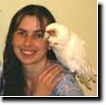Why Create a Prosthetic Nail?
Kristen Reeves, Meadowlark Farms Avian Supply, Inc.
When I first paired my favorite bird to his mate, I was very excited about the results I would see. The pair was very diligent about nest building, mating, and laying eggs. So when not one of those eggs was fertile, I wracked my brain to figure out why.
I thought long and hard about the reasons the eggs would be infertile. I verified that the hen was fertile by pairing her with another cock bird, I reexamined every aspect of my nutritional program, I ran tests for the various bacterial infections that can cause infertility, and watched closely as the pair mated to make sure they were getting it right – yet still no fertile eggs. I finally made the decision that perhaps his missing nail was causing issues during copulation. While the birds look like they are mating, perhaps they just aren’t making good contact!
This bird had lost a nail to injury in his juvenile days. Once we started using prosthetic nails on him, we started to see fertile eggs and now have an abundance of chicks from this pair.
What is the significance of missing toenails in a breeding bird?
In some instances, missing toenails can affect breeding results. Cock birds use their nails to hold on to their mate during copulation. If he is missing even a single nail, fertilization may not occur, potentially causing clear or infertile eggs. This isn’t always the case, but if your bird is missing a nail and your results are inconsistent or negative, this little trick may help.
Many of us have outstanding stock we’d like to get chicks from, so we have to do what is necessary to get those fertile eggs!
While it doesn’t happen often, we do occasionally have birds who lose a toe to injury. When it does happen, we make sure the toe is completely healed then add a prosthetic toenail. It must be noted that this will NOT work if the bird is missing the entire toe - there must be a toe to which the prosthetic may be attached.
What you’ll need –
- A bird of the same species with nails long enough to clip and use as a prosthetic
- Nail clippers
- Alcohol wipes
- Nail file or buffing block
- Blood stopping agent
- Tweezers or Hemostats
- Magnifying glass or Jeweler’s loop
- Nail glue
- Several potential prosthetic nails – I cut several from many birds in case my first attempt to attach the nail is unsuccessful, or I accidentally crush the nail with my hemostats (happens often!).
How to go about it...
The very first thing I do is capture the bird requiring the prosthetic nail and clean the affected toe carefully and thoroughly with an alcohol wipe. The bird is then placed in a clean holding cage until I’m ready to apply the nail.
Next, I capture birds of the same species with nails long enough to trim. I try to clip as many as possible in case I accidentally drop one or crush it while filing. I place the clipped nails in a dish that is easily accessible. I spread the nails around so they are not touching - when I pick up the nail I choose with the hemostats, I do not want to accidentally pick up more than one.
Once I have several nails to use, I pick up each of them and file them carefully to remove any excess bits that may be rough or hanging from the nail. I then place them back in the dish in order of best suited to least suited. Depending on the shape of the toe, you may be able to shape the nail to better affix to the toe. A jeweler’s loop or magnifying glass greatly aids in seeing the actual toe and nail structure.
Once the prosthetic nail is prepared, I take the bird requiring the prosthetic in hand. I then very carefully pick up the prosthetic nail with the hemostats. I add a single drop of nail glue then affix the nail to the bird, centering it on the toe where the natural nail would grow if it still existed. Once in place, it must be held for several seconds to allow the glue to adhere and dry.
NOTE:While I’ve never seen any adverse reactions, it is entirely possible your bird could have an allergic reaction to the glue. Using human grade nail glue has always worked best for me during this process. Super Glue or other household glues are not recommended.
Once the glue is dry, I look closely at the nail to be sure it centered on the toe – if not, it is soaked in alcohol, removed, and replaced. I gently file away any hanging particles, shape the nail, trim it to match the length of the other nails, and make certain it is trimmed on a 45 degree angle so that it will make contact with the perches. I then condition the nail carefully, being sure not to get any ointment on the glued area. Many oil-based ointments will dissolve the glue and allow the nail to fall off sooner than expected.
I do NOT allow the bird to bathe for a few days. Nail glue is water soluble. You do not want to subject it to water until the glue has had several days to set. But because the glue IS soluble, the prosthetic nail WILL eventually fall off. At that point, you can choose to add another - or if it is no longer breeding season, wait until the season rolls around again and then apply another nail at that time.
I have found this method to be VERY effective and hope it helps other breeders get chicks out of birds whose breeding results have been affected by missing nails.
~Sometimes you just have to think outside the birdcage! ~k





